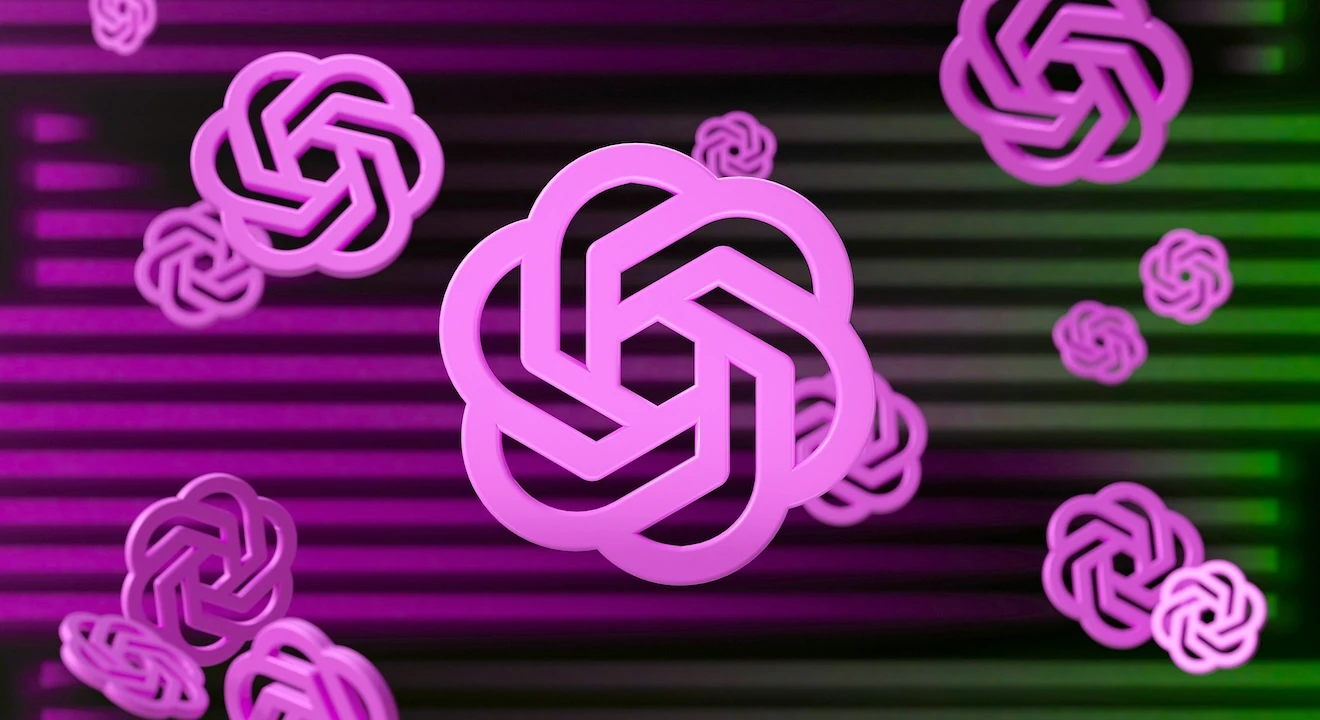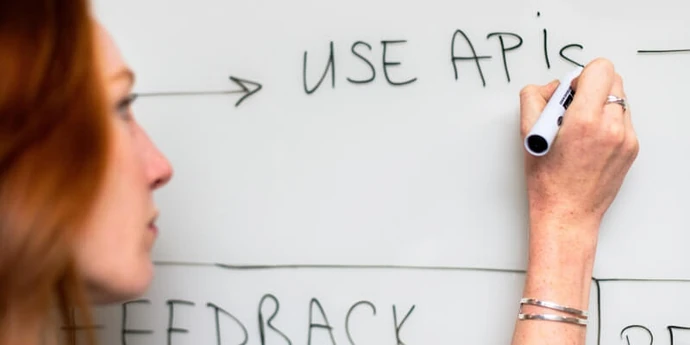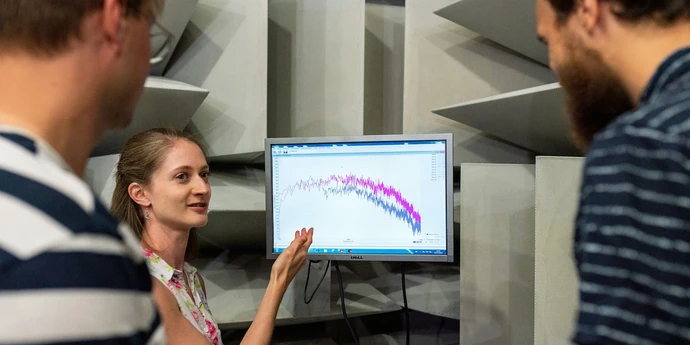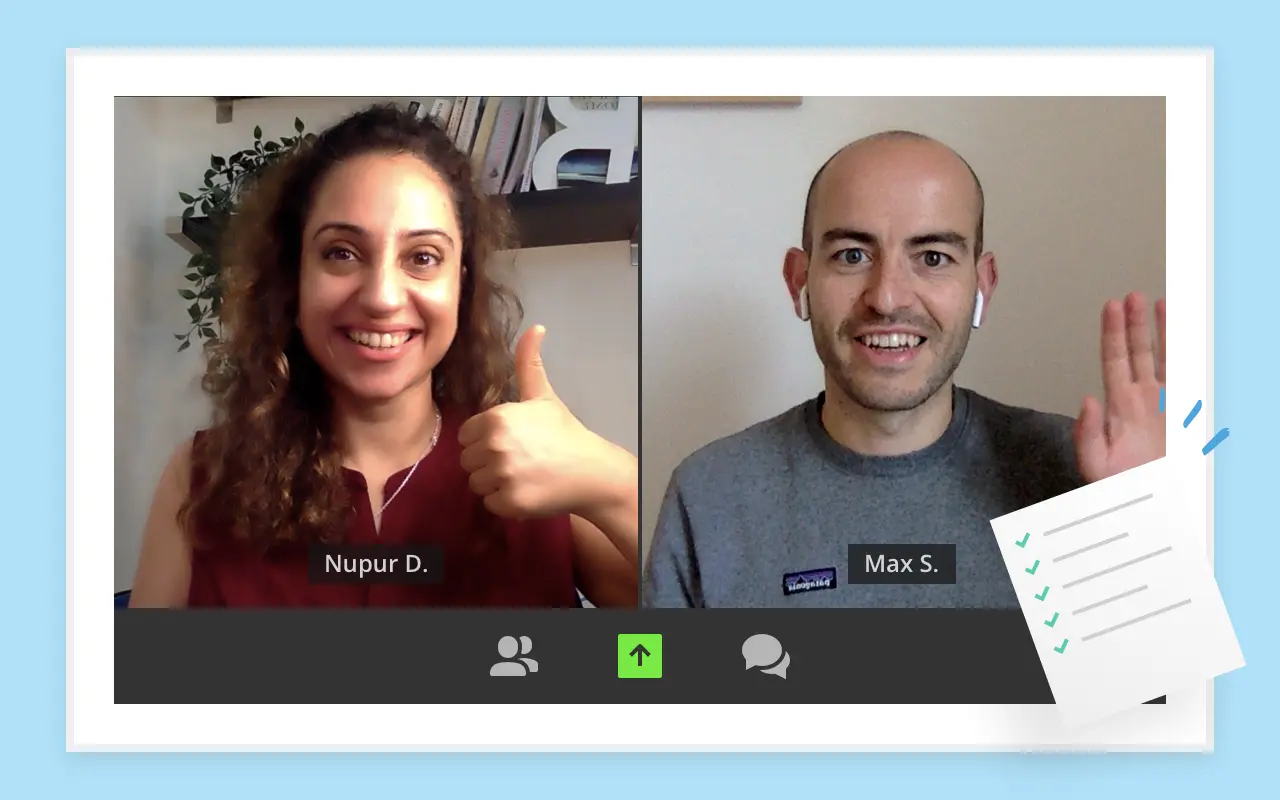OpenAI's interview process is time-consuming and difficult, and not knowing what's ahead makes it even harder to prepare for.
We’re here to help. We work with expert recruiters and interviewers on our platform, who have helped thousands of candidates navigate the interview process at OpenAI and other top tech companies.
Here's what you need to know: OpenAI's interview process can take from 2 weeks up to 2 months, and there are 6 steps, which we’ll get into shortly. The steps that will require the most preparation are the skills-based assessment and the final interviews.
In the rest of this article, we'll dive deep into each step of the recruitment process and how you can prepare for it.
- Step 1: Resume screen
- Step 2: Recruiter call
- Step 3: Hiring manager screen
- Step 4: Skills-based assessment
- Step 5: Final interviews
- Step 6: Decision
Click here to practice 1-on-1 with ex-OpenAI interviewers.
But before we get into each step, let's get to know OpenAI first.
1. About OpenAI ↑
OpenAI is an AI research organization dedicated to ensuring that artificial general intelligence benefits all of humanity. The company was founded in 2015 as a non-profit research lab.
It has since evolved into one of the world's most influential AI organizations, developing groundbreaking models including ChatGPT, GPT-4o, and GPT-4. These systems have fundamentally shaped how businesses and individuals interact with AI.
As expected from one of the world's leading AI companies, OpenAI is incredibly hard to get into, but don't let that intimidate you. OpenAI is not credential-driven, and it seeks to hire talented people with diverse backgrounds who are passionate about collaboratively building safe Artificial General Intelligence (AGI).
2. Working at OpenAI ↑
Not all tech companies are the same. There are subtle differences that make each one unique, such as how decisions are made, how teams collaborate, what truly drives the work, etc. OpenAI is no exception.
If you’re thinking about joining, here’s what makes OpenAI distinct from other tech companies:
2.1 Mission-driven culture
At most tech companies, the product or business model comes first. At OpenAI, it’s the mission.
Everyone at OpenAI is expected to understand and align with the mission of safe, beneficial AI.
You'll be working on what the company views as one of humanity's most important problems: building artificial general intelligence that benefits everyone. This mission permeates hiring, culture, and day-to-day work.
2.2 High autonomy and bottom-up culture
One of the company's operating principles is to "Find a way". Meaning, it gives individuals and teams the autonomy to discover their own approaches to work.
You're expected to take ownership of problems, propose solutions, identify inefficiencies, and drive decisions with minimal hierarchy. This autonomy also means you're directly accountable for your impact.
This is similar to Meta's bottom-up culture but with even more emphasis on individual problem-solving and less reliance on formal processes.
2.3 Intense and fast-moving environment
The work environment reflects the high stakes and mission-critical nature of the company's work.
OpenAI operates with intense focus and urgency. As one of the fastest-moving AI organizations in the world, priorities shift rapidly based on research breakthroughs and product demands.
You'll need to be comfortable with change, capable of learning quickly, and prepared to adapt when circumstances change.
2.4 Collaboration across research, engineering, and product
While autonomous, OpenAI emphasizes strong cross-functional collaboration.
OpenAI's structure requires engineers to work closely with researchers (who may be building novel algorithms), product teams (shipping to millions of users), and safety/alignment specialists (ensuring responsible deployment).
You'll also need strong communication skills to explain technical work to people with different expertise areas.
2.5 OpenAI’s core values
OpenAI’s culture is guided by a set of principles that show up in how its teams operate day to day:
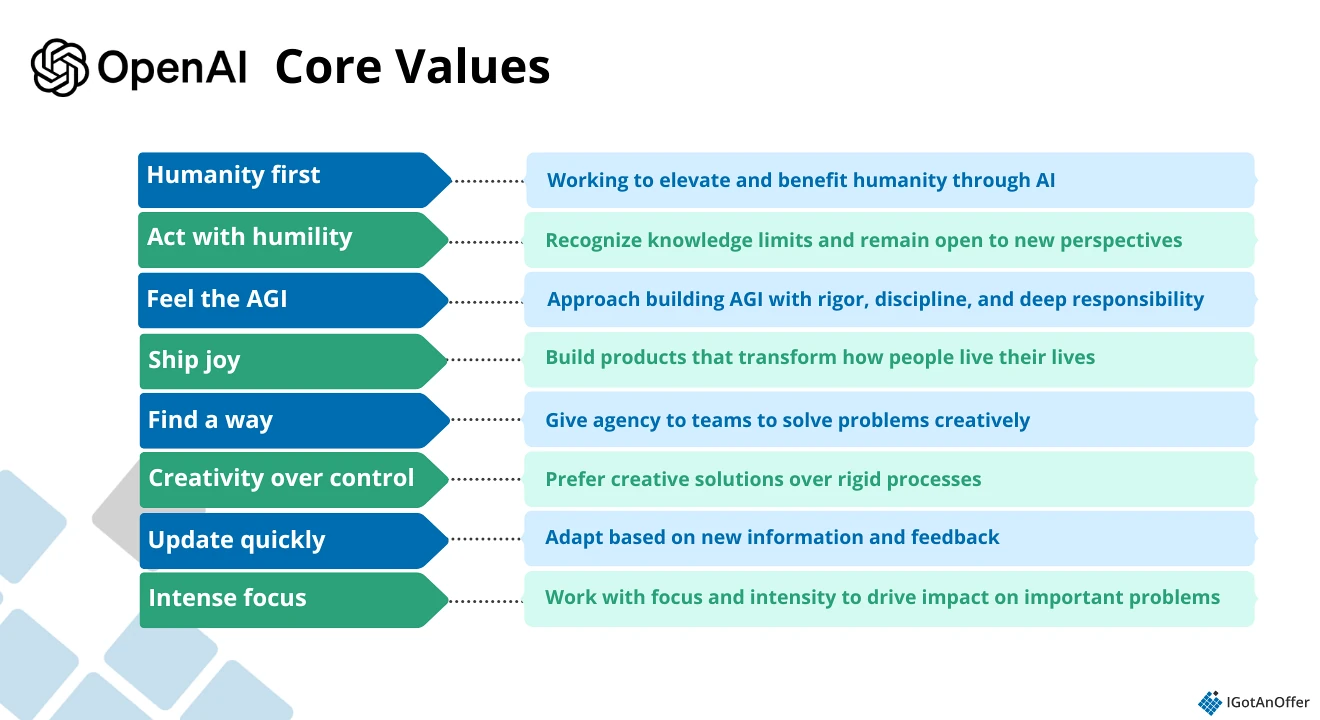
During interviews, you'll be evaluated on how well you align with these values.
You don't need to use the exact language, but being able to demonstrate that you care about these principles, particularly around mission, humility, and creative problem-solving, is important.
Now, let's get into the OpenAI recruitment process.
3. OpenAI Interview Process and Timeline (6 steps to an offer) ↑

Step 1: Resume screen↑
The first step of OpenAI's interview process is the resume screen.
Here, after you've submitted your application through the OpenAI careers portal, or been contacted directly via email or LinkedIn, recruiters will evaluate your resume to see if your experience aligns with the open position.
This is an extremely competitive step. Like other FAANG companies, the vast majority of candidates don't make it past the resume screen.
To help you put together a targeted resume that stands out, follow the tips below:
Tips on crafting a resume
- Study the job description: The work experience you showcase on your resume should directly relate to the role qualifications. For software engineers applying to infrastructure teams, emphasize systems-level work and scale.
- Be specific: Use data to back up your claims. How many servers did you manage? How much did you improve latency? Quantify as much as you can.
- Emphasize impact and scale: OpenAI values people who have worked on systems and problems at significant scale. Highlight work affecting millions of users, massive data processing, or complex distributed systems.
- Be concise: Recruiters often don't have much time to study a resume in depth, so keep it clear and concise, emphasizing roles and achievements that make you stand out.
The guides below are great starting points for making role-specific resumes:
- Software engineering resume examples
- Machine learning engineer resume examples
- Data science resume examples
- Engineering manager resume examples
- Product manager resume examples
- Technical program manager resume examples
However, if you’re looking for expert feedback, you can also get help on your resume from one of our tech recruiters, who will cover what achievements to focus on (or ignore), how to fine-tune your bullet points, and more.
According to OpenAI’s interview guide, this process should take about a week, but be prepared to wait a little longer to hear back.
Step 2: Recruiter call↑
If your resume passes the resume screen, an OpenAI recruiter will reach out to you to schedule a call. This generally lasts 30–45 minutes.
This call is non-technical in most cases. You should expect questions like "Tell me about yourself," "Why OpenAI?" and "Walk me through your resume." Be prepared to discuss your previous experience and explain your motivation for applying to the company.
You may be asked to discuss your work and academic experience, motivations, and goals. Familiarize yourself with OpenAI's recent work, too, especially updates related to the team you're interviewing for. You can find OpenAI's latest research and product updates on their blog.
During this call, the recruiter should give you information on how the overall interview process will work and may answer your questions about the timeline, location, or job description. This is when you should ask about which teams are hiring and express any role preferences.
Your recruiter should also provide you with helpful interview prep materials. If all goes well, the recruiter will get back in touch with you to schedule the skills-based assessment.
Step 3: Hiring manager screen↑
This is typically a 20- to 30-minute virtual call that serves as a screening conversation.
Depending on the role, the hiring manager screen could ask behavioral and resume questions, as well as technical questions about machine learning theory and other basic ML topics.
Be prepared to answer questions about your background (academic and/or professional) and your long-term goals.
If you’re applying for a research position, be prepared to talk about your research and any related publications.
Step 4: Skills-based assessment↑
Within about a week of your recruiter call, you'll progress to the skills-based assessment stage, assuming there's a fit. This is where technical evaluation begins.
The skills-based assessment may include pair coding interviews, take-home projects, system design, or other formats. The recruiting team will provide prep to set you up for success. Still, the formats vary by team, and you may face multiple assessments depending on the role.
What to expect in OpenAI skills-based assessments (for software engineers)
- Coding challenge: A practical coding problem on a platform like HackerRank or CoderPad. OpenAI's coding problems are more practical and real-world focused. For example, debugging an existing function or optimizing code for readability and efficiency.
- System design interview: For more senior roles, you may face a system design problem where you architect a solution to a technical challenge, including API design, database schema, and overall architecture. These questions can be highly detailed with specifications and mockups provided.
- Take-home assignment or pair coding: Depending on the role or team, you might receive a take-home project or participate in a pair coding session where an engineer observes your problem-solving approach.
You can expect to hear back within about a week after completing your assessment. If you advance, the recruiting team will schedule your final interviews.
To see a breakdown of the kind of questions you're likely to face in your skills-based interviews, check out our comprehensive guide to OpenAI interview questions by role (with answers).
Also, if you’re eyeing a product manager role (rather than a software engineer one), read this guide to learn OpenAI's PM-specific interview process and questions.
Step 5: Final interviews↑
If you pass the skills-based assessment, you'll advance to the final interview round. This is the most comprehensive stage of OpenAI's hiring process.
According to OpenAI's official guide, candidates typically go through 4–6 hours of final interviews with 4–6 people over 1–2 days. You may interview virtually (the default) or choose to interview on-site at OpenAI's San Francisco headquarters.
The final interviews at OpenAI look very different from the initial skills assessment. If you’ve already passed the coding and system design stages, you typically won’t repeat them in the final loop. Instead, the focus shifts.
You’ll get 3-5 interviews:
- Coding interview
- System design or architecture interview
- Code refactoring interview (senior roles)
- Project deep-dive and presentation (senior roles)
- Behavioral and culture fit interview
What to expect in OpenAI final interviews
OpenAI says its interviews are "designed to stretch you beyond your comfort zone." It’s why the bar at the company is high.
Even if you solve the problem, if the interviewer has to give you multiple substantive hints or point out logical flaws you missed, that's considered a failure at senior levels. You need to demonstrate independent problem-solving and attention to detail.
1. Coding interview(s)
You'll solve one or more coding problems, often in different formats than the skills assessment. Rather than simple implementation problems, final round coding might include code refactoring challenges or more complex practical problems.
Interviewers are evaluating:
- Well-designed solutions to the problem
- High-quality, clean, maintainable code
- Optimal performance and efficiency
- Good test coverage and edge case consideration
- How you think about trade-offs
- Your communication and collaboration skills
Learn more about how to get better at coding interviews here.
2. System design or architecture interview
For most mid-level and senior roles, you'll face at least one system design interview during the final round. You're expected to discuss trade-offs thoughtfully, design APIs and database schemas, consider scalability and reliability, and even suggest improvements and features sometimes.
Dive deeper into system design and machine learning system design interviews.
3. Code refactoring interview (senior roles)
This is a notably unusual interview type and distinct from typical coding interviews. Rather than building something from scratch, you're given existing, potentially complex code and asked to improve, refactor, or optimize it. This tests your ability to work with real codebases and improve existing systems.
4. Project deep-dive and presentation (senior roles)
For senior software engineer positions, you may be asked to prepare a technical presentation about a significant project you've led. This requires preparing a 4-5 slide presentation beforehand.
You'll walk through the problem and context you faced, your approach and decisions made, trade-offs you considered, the impact and results, and the lessons you learned. It’s OpenAI’s way of assessing your ability to communicate complex technical work clearly, think strategically about engineering decisions, and articulate impact.
You'll be evaluated on clarity, depth of thinking, and whether you can tell a compelling story about your work.
5. Behavioral and culture fit interview
Mission alignment matters a lot at OpenAI. Be prepared to discuss your genuine perspective on AGI safety, alignment, and beneficial AI development. You don't need to be an alignment researcher, but show thoughtfulness about the responsibility of building powerful AI systems.
Learn more about behavioral interview questions.
OpenAI Interview Preparation Tips
- Know OpenAI's recent work: Familiarize yourself with OpenAI's latest research and product updates. Be able to discuss specific projects that excite you and how they relate to the role.
- Prepare stories of impact: Have 5-7 solid stories ready about significant technical work. For each, discuss the problem, your role, decisions you made, trade-offs, impact, and what you learned.
- Study distributed systems fundamentals: Even if not direct infrastructure work, understand consistency/availability trade-offs, scaling strategies, caching, load balancing, and performance thinking.
- Be ready to discuss AI ethics and alignment: Be prepared to share your perspective on responsible AI development and safe AI deployment.
- Practice system design with AGI context in mind: When preparing, think about systems at the scale OpenAI operates. How would you design infrastructure for ChatGPT's scale? What trade-offs would you make? You can read this guide to learn how to properly answer AI or ML-related system design questions.
Once you clear the final interviews, it's time to wait for the decision.
Step 6: Decision
After you finish your final interviews, you should expect to hear back within about a week. But as with most tech companies, expect to wait a little longer, and don’t hesitate to reach out to your recruiter for updates.
Your interviewers will meet to debrief on your performance. The hiring team will review your complete profile—application, skills assessment, and final interview performance.
There are three possible outcomes:
- You receive an offer.
- You receive a rejection (though feedback is often minimal).
- You're asked back for an additional interview (less common, but possible if the committee wants clarification on a specific competency).
After your final interviews, you can expect your recruiter to give you a timeline for the decision.
4. Salary negotiation ↑
Once you've passed through all the steps above and received your offer package from OpenAI, you'll negotiate your offer.
At this point, your recruiter will get in touch about the details and likely schedule a call to discuss the terms. However, it's critical to understand OpenAI's unique compensation structure before you begin negotiations.
4.1 OpenAI's compensation philosophy
OpenAI operates with one of the most unique compensation structures in tech. According to Levels.fyi's data on OpenAI's pay structure, the company has adopted what's been described as "flat salaries with no bonuses and no negotiation."
Here's what this means practically:
- Minimal negotiation room: Unlike Meta, Google, Amazon, and most other major tech companies, OpenAI offers extremely limited room for salary negotiation. Even when you push on salary (citing competing offers, market rates, or other factors), the number either doesn't move or moves only marginally. The company takes a "this is the number" approach.
- No target performance bonus: At most FAANG companies, annual bonuses are a part of total compensation. OpenAI does not have this structure. Your compensation is heavily weighted toward base salary and equity.
- Signing bonuses are extremely rare: OpenAI does not typically offer signing bonuses, even for senior hires or candidates with competing offers.
- Equity structures: Your offer will include equity, but ask detailed questions about vesting schedules, refresh grants, and equity valuation.
4.2 Salary negotiation tips
Given these constraints, here's how to approach your negotiation:
- Do your research: Have a realistic number in mind based on your level and role. Check Levels.fyi and Blind for OpenAI-specific data, factor in the cost of living in San Francisco if relocating, and ideally get input from a current OpenAI employee.
- Be prepared to justify: Why are you asking for higher compensation? Back it up with data, market benchmarks, and the value you bring. Know how your experience translates to impact: whether that’s scaling infrastructure, improving model efficiency, or driving product adoption.
- Leverage competing offers carefully: Mentioning you have competing offers from other companies may not significantly move OpenAI's offer. The company is confident in its mission, and many candidates prioritize working on AGI over maximum compensation.
- Consider the non-monetary value: OpenAI offers something unique: the opportunity to work on what the company views as humanity's most important technology challenges, at a company at the frontier of AI.
For even more detailed guidance, check out our salary negotiation guides. They cover peer FAANG companies like Amazon, Google, and Meta, and the process isn’t too different. Even better, you can work with specialized salary negotiation coaches (including former OpenAI recruiters and hiring managers) for personalized negotiation help.
Once you've accepted your offer, congratulations! It's time to start your career at OpenAI.
5. Are you prepared for your OpenAI interviews? ↑
Learning by yourself is an essential first step. We recommend you make full use of the free prep resources on this blog. That way, you can see what an excellent answer looks like.
You can start by reading these free interview guides, both for OpenAI and other similar AI-focused tech companies:
- OpenAI interview questions (by role, with answers)
- OpenAI product manager interview
- Anthropic interview process
Once you’re in command of the subject matter, you’ll want to practice answering questions. But by yourself, you can’t simulate thinking on your feet or the pressure of performing in front of a stranger. Plus, there are no unexpected follow-up questions and no feedback.
That’s why many candidates try to practice with friends or peers.
We've coached more than 20,000 people for interviews since 2018. In our experience, practicing real interviews with experts who can give you company-specific feedback makes a huge difference.
Find an OpenAI interview coach so you can:
- Test yourself under real interview conditions
- Get accurate feedback from a real expert
- Build your confidence
- Get company-specific insights
- Learn how to tell the right stories, better
- Save time by focusing your preparation
Landing a job at a leading AI company like OpenAI often results in significant career growth and the opportunity to work on transformative problems. Three or four coaching sessions worth ~$500 make a great difference in your ability to land the job.
Frequently asked questions about the OpenAI interview process and timeline ↑
How many rounds of interviews are there at OpenAI?
Most candidates report 5-7 total rounds, counting recruiter calls through final interviews, though this varies significantly by role and seniority.
How long is the OpenAI hiring process?
The OpenAI hiring process typically takes 2 to 4 weeks. However, as with any FAANG company, the duration can vary, particularly for senior roles or when scheduling extends the timeline. The company advises checking in with your recruiter if you haven't heard back within a week after each stage.
How difficult are OpenAI interviews?
OpenAI interviews are challenging, reflecting the company's high bar for technical depth. However, candidate experiences vary. Regardless, you need to prep and practice a lot.






